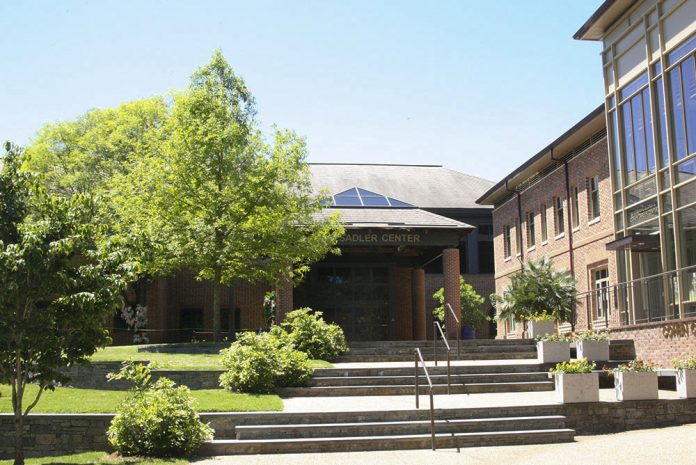Award-winning author Tommy Orange visited the College of William and Mary Thursday, Jan. 23 to hold a discussion about his novel “There, There.” The discussion was moderated by American Indian Resource Center Director Danielle Moretti-Langholtz, and Orange was formally welcomed by the president of the College’s American Indian Student Association President Carolina Wasinger ’22.
Orange is an enrolled member of the Cheyenne and Arapaho tribes of Oklahoma and grew up in Oakland, California. “There, There” and many of Orange’s other fictional works center on the Native-American experience in the United States, especially in urban spaces like Orange’s hometown of Oakland.
“There, There,” Orange’s first novel, won the 2019 Hemingway Foundation/PEN Award, the 2018 National Book Critics Circle Award’s John Leonard Prize, the 2018 Center for Fiction First Novel Prize and the 2019 Anisfield-Wolf Book Award for Fiction. “There, There” was also a 2019 Pulitzer Prize Finalist in Fiction and was shortlisted for the 2019 Andrew Carnegie Medal for Excellence in Fiction. More directly to developments in Williamsburg, the book was also chosen as the common book for the College’s class of 2023 by the Dean of Students Office.
Orange’s novel tells the story of 12 Native-American characters in the Oakland area whose stories coalesce around a single climactic event. The point of view of “There, There” switches between different perspectives throughout the story since Orange utilizes both first- and third-person narration. The book’s title is a reference to a passage from fellow Oaklander Gertrude Stein’s memoir “Everybody’s Autobiography.”
In his talk, Orange expanded on his writing style and elaborated about how he constructed his novel. Orange also read aloud a selected passage from the book, and focused his conversation around the struggle and progress of Native-American authors in reclaiming narrative territory which has historically been ceded to non-Native-American people.
“There’s something true about what I’m talking about through these different characters and something true about the function of stories in different cultures, in our culture; it’s a constant narrative battle, reality is,” Orange said.
“There’s something true about what I’m talking about through these different characters and something true about the function of stories in different cultures, in our culture; it’s a constant narrative battle, reality is,” Orange said. “Native people have not been able to own our own stories and we haven’t been able to define ourselves; we’ve been defined by the outside, and this is all storytelling under different names. … It’s people wanting narrative control.”
Another recurring topic of discussion was the contrast between the stereotypical view of Native-American people as historical objects living on isolated reservations. Rather, Orange’s and other Native-American people’s experiences in urban and other settings seeks to demonstrate a more realistic view of native peoples and their relationship with nature.
“In thinking about identity and being Native and what it means, and being from the city, I wanted to get away from this idea of reservation or relationship to land meaning nature, and have there be a way that somebody could relate to their environment and that be the place that they belong and be home and still be sort of man-made or artificial,” Orange said. “The values don’t stop at man-made versus nature. It’s all part of what reality is; just because it’s manufactured doesn’t mean it’s not a part of what you’re relating to. It’s your environment.”
Anthropology doctoral student Graham Calloway enjoyed the discussion and was impressed with Orange’s work.
“I think it’s a wonderful thing to see a Native person be such a successful author and I hope we see more of that and that this is part of trend,” Calloway said.
“I think it’s a wonderful thing to see a Native person be such a successful author and I hope we see more of that and that this is part of trend,” Calloway said.
Maggie Aschmeyer ’20 said she found the passage from “There, There” that Orange read aloud the most memorable part of the discussion.
“I feel like everything he said was really poignant,” Aschmeyer said. “I remember when he read aloud the bit from the book, there were just some really beautiful phrases in that.”
Maggie Gentry ’21 read “There, There” before the discussion and said that the discussion helped provide a better perspective on Orange’s literary style.
“I think it was interesting for him to talk about his influences in writing, because I really enjoy writing, so it was really interesting to hear about his process,” Gentry said.
Towards the end of the discussion, a member of the audience asked Orange about his opinion of the College’s use of the word “tribe” in its athletic teams and branding.
“People holding on to traditions is understandable, but people holding on to traditions when they know it hurts other people seems really petty,” Orange said. “I strongly feel that no one should be using our imagery for mascot territory. It’s only animals and objects, so it shows you what they think of us if they’re using us that way, so I’m strongly against it, but I don’t know what to do about it because institutions are hard to move. It’s machinery and there are a lot of old pieces in there that are stubborn.”

